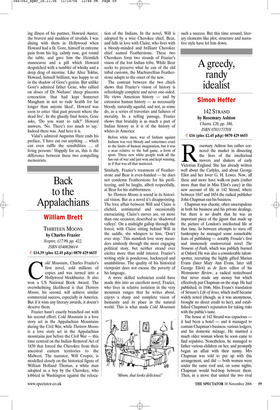Back to the Appalachians
William Brett
THIRTEEN MOONS by Charles Frazier Sceptre, £17.99, pp. 422, ISBN 0340826614 ✆ £14.39 (plus £2.45 p&p) 0870 429 6655 Cold Mountain, Charles Frazier’s first novel, sold millions of copies and was turned into a Hollywood blockbuster. It also won a US National Book Award. The overwhelming likelihood is that Thirteen Moons, his second, will achieve similar commercial success, especially in America. But if it wins any literary awards, it doesn’t deserve them.
Frazier hasn’t exactly branched out with his second effort. Cold Mountain is a love story set in the Appalachian Mountains during the Civil War, while Thirteen Moons is a love story set in the Appalachian mountains just before the Civil War — this time centred on the Indian Removal Act of 1830 that forced the Cherokee from their ancestral eastern territories to the Midwest. The narrator, Will Cooper, is modelled closely on the historical figure of William Holland Thomas, a white man adopted as a boy by the Cherokee, who lobbied in Washington against the reloca tion of the Indians. In the novel, Will is adopted by a wise Cherokee chief, Bear, and falls in love with Claire, who lives with a bloody-minded and brilliant Cherokee chief named Featherstone. These two Cherokees form two strands of Frazier’s vision of the lost Indian tribe. While Bear seeks to preserve what he can of the old tribal customs, the Machiavellian Featherstone adapts to the onset of the new.
The contrast between the two chiefs shows that Frazier’s vision of history is refreshingly complete and never one-sided. He views American history — and by extension human history — as necessarily bloody, naturally squalid, and not, as some do, as a series of travesties and failures of morality. In a telling passage, Frazier shows that brutality is as much a part of Indian history as it is of the history of whites in America:
Before white men, war of Indians against Indians was very bloody and sometimes cruel to the limits of human imagination, but it was a near relative to the ball game, a form of sport. These new white people took all the fun out of war and just won and kept winning, as if that was all that mattered.
Similarly, Frazier’s treatment of Featherstone and Bear is even-handed — he does not condemn Featherstone for his profiteering, and he laughs, albeit respectfully, at Bear for his stubbornness.
So Thirteen Moons is sound in its historical vision. But as a novel it’s disappointing. The love affair between Will and Claire is clichéd, sentimental and occasionally excruciating. Claire’s curves are, on more than one occasion, described as ‘shadowed valleys’. On a midnight gallop through the forest, with Claire sitting behind Will in the saddle, she whispers to him, ‘Don’t ever stop.’ This mawkish love story meanders aimlessly through the more engaging political story, but neither strand ever excites more than mild interest. Frazier’s writing style is ponderous, hackneyed and unambitious. The quality of his historical viewpoint does not excuse the poverty of his language.
A more skilled technician could have made this into an excellent novel. Frazier, who lives in relative isolation in the very mountain ranges that he writes about, enjoys a sharp and complete vision of humanity and its place in the natural world. This is what made Cold Mountain such a success. But this time around, literary elements like plot, structure and narrative style have let him down.


































































































 Previous page
Previous page